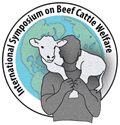The Economics of Animal Welfare
Recent studies of how welfare concerns affect aggregate meat demand indicate expenditures for pork and poultry have declined by 2.5% and 5%, respectively.
MANHATTAN, Kan. (May 21, 2010) — What can an economist add to the discussion of animal welfare? During the International Symposium on Beef Cattle Welfare, Kansas State University Agricultural Economist Glynn Tonsor said surveying how consumers spend money at the meatcounter reveals something about their animal welfare concerns. According to Tonsor, results indicate the beef industry cannot afford complacency.

"The evidence shows there is a high cost of not being engaged in the discussion," Glynn Tonsor says of the animal welfare movement.
It’s true, Tonsor admitted, that animal welfare advocacy groups have focused more attention on the pork and poultry industries. Still, surveyed consumers say they are concerned about the welfare of beef cattle. They don’t, however, always make a clear distinction between beef and dairy cattle. Regarding practices such as castration, tail-docking and confinement feeding, consumers don’t always distinguish between animal species. And regardless of species, consumers associate “good” animal welfare practices and higher food safety with meat from animals produced on small farms.
“The thing to remember,” Tonsor warned, “is that no meat industry (segment) is immune from scrutiny.”
Tonsor said voter response to state ballot initiatives designed to regulate certain animal production practices also signal what is on consumers’ minds. Survey results suggest as many as 70% of consumers, across the United States, would support national requirements similar to those adopted in California through that state’s Proposition 2 ballot initiative. That suggests a need for more education about meat production.
Consumer perceptions regarding the accuracy of information provided by meat industry sources does influence consumer thinking, Tonsor added. The key is to convince consumers that industry information is more accurate than that promoted by opposing activist groups.
“The evidence shows there is a high cost of not being engaged in the discussion,” he stated.
According to Tonsor, recent studies of how welfare concerns affect aggregate meat demand indicate no significant effect on consumer expenditures for beef. However, expenditures for pork and poultry have declined by 2.5% and 5%, respectively. When a reduction occurs for one meat product, expenditures do not necessarily shift to another. Instead, consumers tend to spend that money on non-meat items.
To Tonsor, that means a broader, collaborative meat industry response is needed, rather than species-specific action.
“Remember that perception drives decisions, whether it is based on accurate knowledge or not. Be aware, think carefully and be proactive,” Tonsor advised. “Remember consumers are concerned about animal welfare. Producers probably won’t get paid more for improving animal welfare conditions. Not in the short term. But you really don’t have a choice.”
The beef cattle welfare symposium was conducted on campus at K-State University May 19-21. For additional presentation summaries, return to the Meetings > Other Industry Meetings > News Coverage page of the API Virtual Library. For more about the symposium and an archive to the 2008 symposium, visit www.isbcw.beefcattleinstitute.org.
Editor's Note: This article was written under contract or by staff of Angus Productions Inc. (API), which claims copyright to this article. It may not be published or distributed without the express permission of API. To request reprint permission and guidelines, contact Shauna Rose Hermel, editor, at 816-383-5270.

